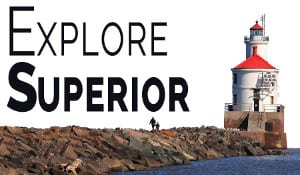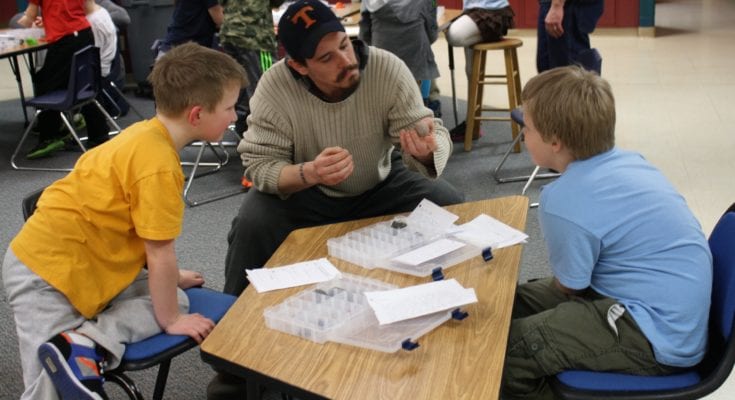These Kids Really Have Rocks in Their Heads!
By Mary Johnson-Garay, 3rd Grade Teacher, Great Lakes Elementary School

Two students in Mrs. Johnson-Garay’s class analyze the components of a sedimentary rock inside their rock boxes. The rock boxes were put together by UWS Geology students.
What does a class of third graders from Great Lakes Elementary and a group of students from UWS have in common? Rocks and Minerals!
Third graders from Mary Johnson-Garay’s classroom teamed up with Andy Breckenridge’s Geology students to share their knowledge of rocks, work together on rock cycle activities and to develop a deeper understanding of rocks and minerals.
Generating authentic learning for the students is a great way to make rocks even more interesting. The UWS students put together “rock boxes” for their partners. The boxes included a personal letter, carefully numbered rocks, and a blank answer sheet asking students to name each rock. The third grade students used their prior knowledge and a variety of resources to identify each rock.
Next the UWS students took a field trip to Great Lakes to visit the students. The room was buzzing with conversation about rocks, magnifying glasses were in hand to assist the curious eyes in the search of the various characteristics needed to classify each rock, and soon the identity of the various rocks within the boxes became clear.
The students worked together creating the rock cycle through the use of play dough. They built volcanoes with lava oozing out, added some weathering and erosion to create sediment, applied pressure to form sedimentary rock and finally applied more heat and pressure to create metamorphic rock. In the end the students had some pretty fancy “metamorphic rocks” to bring home.
Andy Breckenridge shared a variety of fossils, petrified wood and interesting rocks with the students. Attempting to identify the diverse rocks became a team effort.
The Rock Cycle Crayon experiment was the final activity the team worked on together. Once again they took their igneous rocks (crayons), shaved them with plastic knives to mimic weathering and erosion, applied pressure to their sediments to form a sedimentary rock, added heat and pressure to create a metamorphic rock and then melted the metamorphic rock to return back to magma; the beginning of the rock cycle.
Throughout the spring the students will pass letters back and forth, sharing, identifying and quizzing each other on their favorite rocks. An unlikely partnership, but a great learning experience for all!





